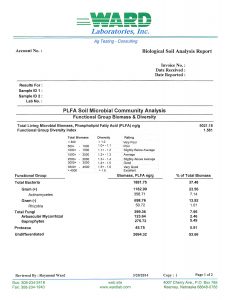Biotesting Information (PLFA)
Lance Gunderson, Ward Laboratories Inc.
Soil is a complex ecosystem that provides a habitat for an endless array of micro and some macro-organisms. These include bacteria, fungi, protozoa, nematodes, earthworms, etc. These organisms are responsible for much of the nutrient cycling that takes place in the soil. They decompose crop residues, store plant nutrients, create stable organic matter in the form of humic acid, and help build soil structure. This leads to reduced soil compaction and erosion while increasing water holding capacity and a deeper root zone. The relationship between different microorganisms and plants is dynamic. The predatory action of protozoa on bacteria helps release nitrogen into the soil and symbiotic bacteria and fungi aid the plant in acquiring more nutrients. Through a better understanding of soil microbial communities, we can begin to allow these organisms to work for us in our goal of high yielding, sustainable agriculture.
 Soil microbial community testing at Ward Laboratories is conducted by analyzing phospholipid fatty acids or PLFA. These fatty acids are found in the cell membranes of living organisms, from bacteria to plants and animals. However, they degrade relatively quickly in the soil when an organism dies and the membrane begins to break down. These characteristics make extracting and quantifying PLFA from the soil a powerful tool for estimating living microbial biomass. In addition, PLFA biomarkers, or signature fatty acids, allow us to identify the presence or absence of various functional groups of interest such as different bacterial groups, actinomycetes, arbuscular mycorrhizal fungi, rhizobia, protozoa, etc. PLFA is a snapshot of community structure and abundance at the time of sampling. As environmental conditions such as pH, temperature, and moisture change so does the microbial community. These communities are also influenced by soil type, organic matter, intensity and type of tillage, crop rotations, cover crops, and herbicide or pesticide applications. The ability of microbial communities to change rapidly provides producers with a tool to compare agricultural management techniques with respect to overall better soil health and fertility.
Soil microbial community testing at Ward Laboratories is conducted by analyzing phospholipid fatty acids or PLFA. These fatty acids are found in the cell membranes of living organisms, from bacteria to plants and animals. However, they degrade relatively quickly in the soil when an organism dies and the membrane begins to break down. These characteristics make extracting and quantifying PLFA from the soil a powerful tool for estimating living microbial biomass. In addition, PLFA biomarkers, or signature fatty acids, allow us to identify the presence or absence of various functional groups of interest such as different bacterial groups, actinomycetes, arbuscular mycorrhizal fungi, rhizobia, protozoa, etc. PLFA is a snapshot of community structure and abundance at the time of sampling. As environmental conditions such as pH, temperature, and moisture change so does the microbial community. These communities are also influenced by soil type, organic matter, intensity and type of tillage, crop rotations, cover crops, and herbicide or pesticide applications. The ability of microbial communities to change rapidly provides producers with a tool to compare agricultural management techniques with respect to overall better soil health and fertility.
Soil fertility and biological tests can be run on any soil sample. However, there is no baseline for biological testing as there is for a fertility analysis. Therefore, this test is most useful in making comparisons between management conditions such as till vs. no-till, different fertilizer applications, crop rotations, various mono cover crops or mixes, grazing vs. no grazing, etc. The main focus is to compare various agricultural techniques and their effects on soil microbiology as well as fertility. Trying to tie the two related, but different, forms of testing together for sustainable farming is the main goal.
Click one of the links below to view and download soil health test information from Ward Laboratories.
 PLFA Soil Testing
PLFA Soil Testing
Haney Soil Testing
- Test Info
- Sampling Info
- Report Example
- Report Definitions
- Interpretation Guide
- List of References
- Extra Links
